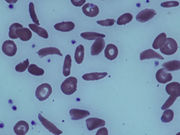However, SC trait was linked with significantly higher risk of exertional rhabdomyolysis
WEDNESDAY, Aug. 3, 2016 (HealthDay News) — Sickle cell trait is not associated with a higher risk of death than absence of the trait, but it is associated with a significantly increased risk of exertional rhabdomyolysis, according to a study published in the Aug. 4 issue of the New England Journal of Medicine.
D. Alan Nelson, Ph.D., from the Stanford University School of Medicine in California, and colleagues examined whether the risks of exertional rhabdomyolysis and death varied according to sickle cell trait status. Data were included for 47,944 black soldiers who had undergone hemoglobin AS testing and were on active duty in the U.S. Army.
The researchers found that the risk of death did not differ significantly for soldiers with versus those without the sickle cell trait (hazard ratio [HR], 0.99; 95 percent confidence interval [CI], 0.46 to 2.13); however, the trait correlated with significantly elevated adjusted risk of exertional rhabdomyolysis (HR, 1.54; 95 percent CI, 1.12 to 2.12). The magnitude of this effect was similar to that associated with tobacco use versus non-use (HR, 1.54; 95 percent CI, 1.23 to 1.94) and to that associated with having a body mass index of 30 kg/m² or more versus less than 25 kg/m² (HR, 1.39; 95 percent CI, 1.04 to 1.86). The effect was less than that associated with recent statin use or antipsychotic agent use.
“Sickle cell trait was not associated with a higher risk of death than absence of the trait, but it was associated with a significantly higher risk of exertional rhabdomyolysis,” the authors write.
Full Text (subscription or payment may be required)
Copyright © 2016 HealthDay. All rights reserved.








